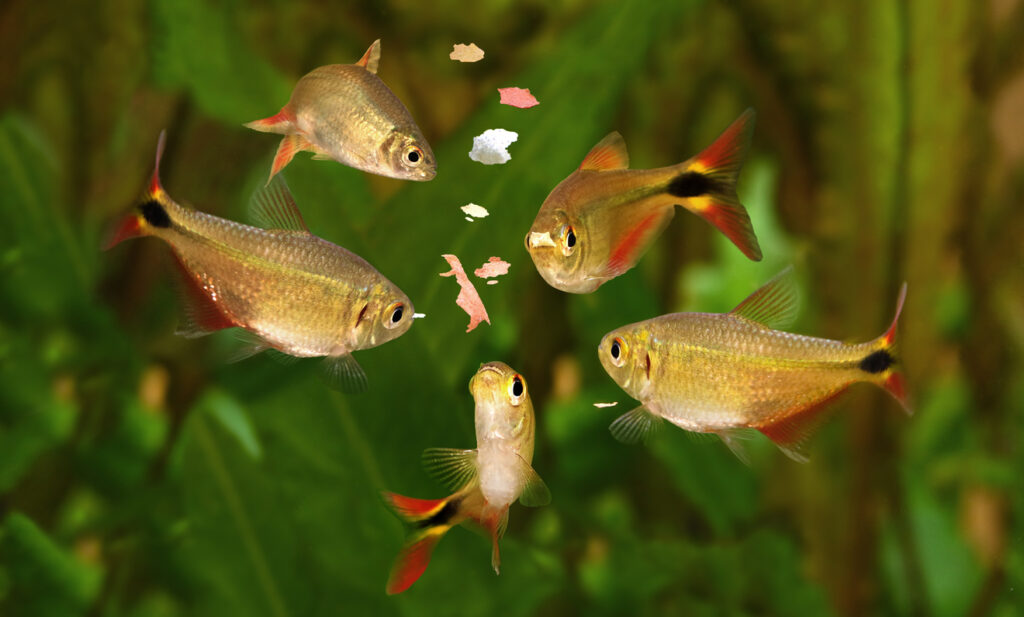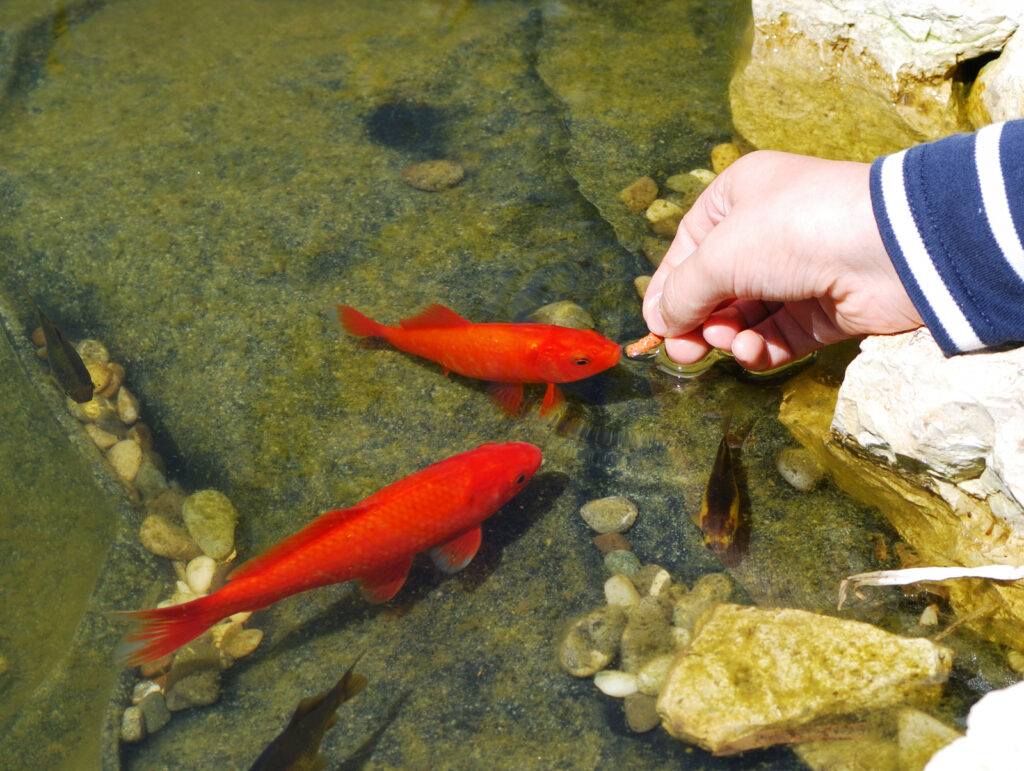You may have noticed that your fish always want to be fed – but should you give them a meal every time they look keen? If you’re wondering how often to feed fish, it’s worth bearing in mind that these little creatures may well have eyes bigger than their stomachs! This is because fish in the wild don’t always have access to food, so they’ve learnt to gobble up food whenever they find it.
Since fish are always up for a meal, it’s easy to overfeed them, but this can cause problems for their health and the tank. Read on to find out how to feed fish to keep them healthy and happy.

How often to feed fish
A good rule of thumb is to feed your fish once or twice a day, but the best routine really depends on the type of fish that you have. Larger fish that are less active can go longer between meals than smaller fish that whizz about all the time! Newly hatched fry are tiny and they’ll need more frequent feeding – maybe three to four feeds per day.
Another factor that affects how often fish need feeding is what they eat in the wild. Fish who eat meat will be able to survive a fair while between meals, because they’ll be adapted to cope in the times when they can’t find prey. On the other hand, fish who only eat plants will naturally graze throughout the day, so they tend to need more frequent small feeds.
But what about if you’re going away? Most types of fish will be fine without food for a day or two, but if you’re away for a while and you don’t have a ‘fish sitter’, you can get blocks of vacation fish food that slowly release food into the water to keep your fish well fed.
How often should you feed fish in a pond?
For fish kept in a pond outside, the best feeding plan depends on how many fish you have, how big your pond is and what’s growing in it. If your pond is well stocked with water plants and you don’t have many fish, you may find that there’s enough natural food to keep them going most of the time. However, pond fish will often also need some pond fish food to keep them happy and healthy.
The amount to feed does vary with the seasons. As fish are cold blooded, they won’t be very active in cold weather and so they’ll need less food when it’s chilly. When the water is very cold in the winter, it’s best not to feed at all. Fish will generally stop showing interest in food once the water temperature drops below about 10˚C.

What can you feed fish?
The right food for your fish depends on what they would eat in the wild. Carnivores (meat eaters), herbivores (plant eaters), and omnivores (who eat both) will have different dietary requirements, so it’s important to make sure that you’re feeding to meet the needs of all the fish in your tank. For some types of fish like catfish, you can buy species-specific food to cater for their particular requirements.
Another consideration is how big your fish are. The size of the pieces of food should correspond to the size of their mouth – tiny fish won’t be able to handle larger pellets, and larger fish won’t necessarily notice small flakes.
When you’re choosing between types of food, it’s also important to consider where in the tank your fish tend to live and eat. Some fish are ‘top feeders’, meaning they nibble food as it floats on the surface of the water. Other fish are ‘mid-feeders’, and they’ll eat food as it sinks to the bottom. Some flake foods are a good choice for top and mid feeders, as the flakes will float for a while then slowly sink. The final type of feeders are bottom feeding fish, and they will need food that sinks such as tablets and pellets.
How much to feed?
When it comes to quantities, it’s important not to give too much because overfeeding can cause health issues and uneaten food can pollute the tank. To avoid these problems, it’s safest to err on the side of caution and then give a little extra if you need to. A general guide is to give no more than your fish will eat in about three minutes – but if you find they’ve snaffled it all in much less than two minutes, you may want to give a little more.
Some fish eat faster than others, and the ‘three minutes’ advice is only a general guideline. Some people find that two minutes is plenty, while others advise sprinkling small quantities for up to five minutes. What’s important is that there should be no uneaten food left in the tank after feeding.
While you’re feeding your fish, it’s worth making sure that all of them get their fair share. If you put all the food in one place, it may be that the dominant fish get a big meal while shyer fish lose out. If you sprinkle the food more widely and note where your shy fish are, you’ll have a better chance of keeping everyone happy.
What happens if you overfeed fish?
Fish will generally stop eating once their tummies are full, though certain species such as betta fish tend to overeat at mealtimes if they get the chance. But if fish fill their bellies too frequently, they can develop health problems such as obesity and fatty liver disease.
On top of the direct health effects of overfeeding, there’s also the potential for problems with the water quality that can also make your fish poorly. What happens is that uneaten food decays in the tank, making the water go cloudy as bacteria build up. While overfeeding is not the only reason why fish tank water is cloudy, it is a fairly common cause. As well as bacteria, little patches of cottony fungus can develop on uneaten food, and you may find that algae grows too. To deal with algae, it’s important to use a good quality filter as well as making sure that the fish are getting the right amount of food.
Decaying food also reduces oxygen levels in the water and increases the amount of ammonia, phosphates and nitrates, which you might pick up on water testing. These changes can stress fish, making them more prone to diseases like fin rot. So, to reduce these problems, it’s important to avoid overfeeding and remove any excess uneaten food after five to ten minutes using a siphon or a net.
We hope this was a useful guide on how to feed fish! If you want to pick up more hints and tips on pet care, sign up below…


